Pear variety Cure (Williams winter)
Curé is an early winter triploid pear variety of unknown origin. The seedling was discovered by accident in 1760 in France, in the Fromenteau forest, Cure Leroy, thanks to which the variety was further spread. Other names of the variety are Williams winter, Winter large, Pastorskaya, Plebanovka, Popskaya.
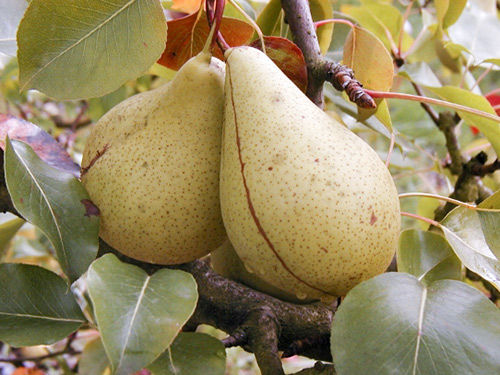
In 1947, the variety was sent to the State test and in the same year it was zoned in the North Caucasus region. Within Russia, this pear is most widespread in the Krasnodar and Stavropol Territories, in the southern part of the Astrakhan Region, Crimea, Dagestan, Ingushetia, Chechnya, North Ossetia, Kabardino-Balkaria. It is also cultivated in Azerbaijan, Moldova, Armenia, in all zones of Ukraine and the republics of Central Asia.
The trees are vigorous and durable. The crown is well leafy, dense, broad-pyramidal in shape (at the age of 12, the crown diameter is 3.9 meters). When the crop is loaded, the ends of the branches go down, and the crown takes on a slightly drooping shape. The main branches extend from the trunk at an acute angle (approximately 45-50 degrees). The bark of the trunk and the main skeletal branches is gray and covered with cracks; on young trees, the surface of the bark is smooth, gray, without cracks. Fruiting is concentrated on 3 - 4-year-old wood (less often on 2-year-old), as well as on fruits.
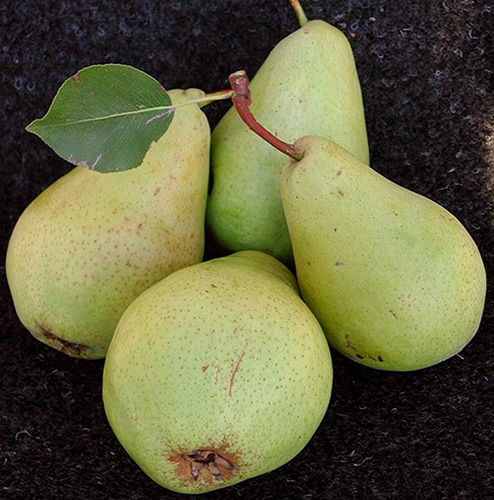
Shoots are geniculate, medium or long in length, medium in thickness, light brown in color. The bark of the upper part of annual shoots is colored burgundy brown and slightly pubescent. Lentils are medium in size, oval in shape, light gray in color, rarely located on the shoot. The buds are medium in size, protruding, conical in shape, with pointed tips, dark brown colored and covered with gray scales. The variety has good shoots. The leaves are dark green, medium in size, broadly ovate or almost rounded, with raised edges and short tips bent downwards. A fine, sharp-serrated serration runs along the edge of the leaves. Leaf blade with a smooth, glossy surface, rather thick, leathery. The petioles are small, thin, often colored burgundy.
Flowering occurs early. The flowers are quite large in size, white in color, the anthers are painted in a dark pink color.
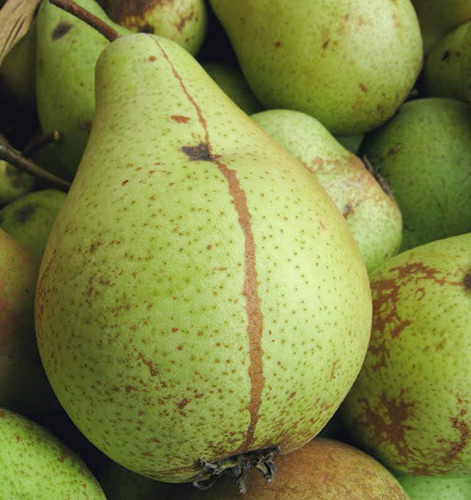
The fruits of the Curé pear are above average (weighing 160 - 190 g) or large (weighing 200 - 250 g, there is also information about specimens weighing up to 500 g), slightly asymmetric, elongated pear-shaped in shape. Closer to the calyx, the pears taper into a truncated cone. The skin is smooth, matte, rather thick and firm. When removed, the main color of the fruit is light green, at the time of ripening it is whitish-lemon-yellow. The coat color is expressed through a faint pinkish blush or is not visible at all. Subcutaneous points are small, subtle, numerous. On individual fruits, you can notice a characteristic characteristic of the variety: a rusty-brown strip runs along the length of the entire pear, from the calyx to the stalk. The peduncles are long, slightly curved, set obliquely (obliquely), the thickness is medium, there is a thickening at the point of attachment of the branch; the grip of the peduncle with the fruit is strong, a fleshy tubercle grows in this place. The depression at the calyx is shallow, wide, smooth, and slight rustiness is often present. The cup itself is large, open; sepals are large, elongated, in the calyx are located in the form of an asterisk. The seed nest is medium-sized, elongated, surrounded by numerous granulations. The seed chambers are ovoid, narrow, with few seeds. Seeds are elongated, yellow-brown in color.
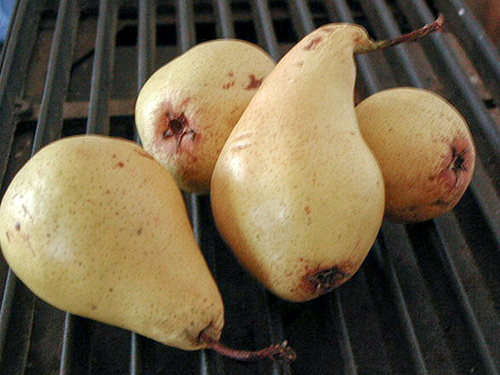
The pulp is usually white (in rare cases - yellowish or creamy), fine-grained consistency, medium density, tender, semi-melting, medium-term, with a slight nutmeg aroma, slight astringency and granulation (stony cells) at the seed nest, often satisfying sweet and sour taste. The taste can be more herbal or practically tasteless in unfavorable years. In general, the taste of the Curé pear varies greatly depending on the growing conditions, therefore the tasting taste rating is not too high and usually ranges from 3.0 to 3.5 points. But if with early removal the taste is clearly mediocre, then during storage the taste of the fruit still becomes better. By chemical composition, pears contain: dry matter (10.8%), the amount of sugars (6.5%), titratable acids (0.7%), ascorbic acid (3.8 mg / 100 g), P-active catechins (38.6 mg / 100 g fr wt). The fruits are mostly consumed fresh, but are also often used for processing. Compotes are obtained with a mediocre taste (3.5 points).
In the conditions of the Kuban, fruit picking is carried out in the interval from September 25th to October 8th. Pears are very often tied in bunches and at the same time are firmly held in the trees. They ripen in bed for 15 - 20 days and are stored for 1 - 2 months. In the process of ripening, the fruits begin to brown rather quickly and deteriorate. In these conditions, their rapid implementation is required. When overripe, pears get agonized. They lie in the refrigerator until January, at the most - until February. The variety tolerates transportation well.
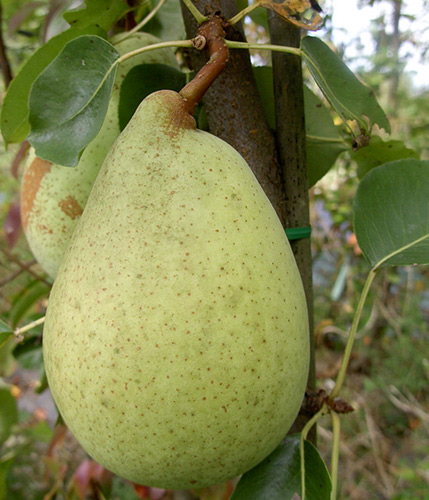
The early maturity of the Curé pear is estimated at an average level. Trees bear fruit from the 5th-6th year, on the quince - from the 4th-5th year. The variety works best on well-developed rootstocks (forest pear seedlings) and quince. On a quince rootstock, trees grow very well and often move on to their own roots. It was also noted that the largest fruits (weighing up to 500 grams) grow on quince rootstocks. It is important to note that under the conditions of the nursery, the seedlings of this variety are developing very rapidly. In this regard, they are often used as an intermediate insert for those pear varieties that fail on quince. Pruning is usually done by thinning the thickening branches in the crown and lightly shortening the continuation shoots.
The tree is self-fertile. The best pollinators of Curé include varieties: Williams, Clapp's Favorite, Bere Bosc, Bere Ardanpon, Olivier de Serre, Winter Deccan, Duchess Angoulême, Saint-Germain.
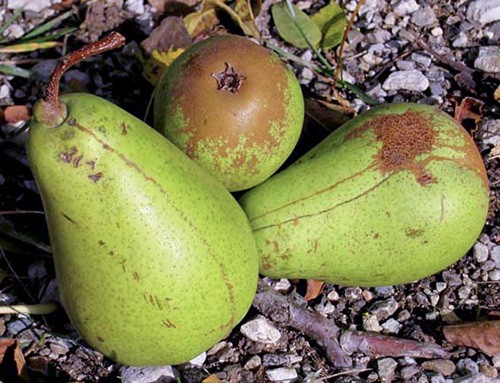
Highly productive variety. Fruiting is often regular and generous. In the central part of the Kuban, the average yield of 17 - 20-year-old trees is 150 - 180 kg / ha, in the foothill zone 24 - 26-year-old trees yield up to 200 - 250 kg / ha (or up to 200 - 300 kg / der). From individual 20 - 25-year-old trees, you can collect up to 500 - 600 kg of fruits in favorable years.
This pear is quite winter-hardy and drought-resistant. In case of freezing, trees recover well and quickly, continuing abundant fruiting. Despite the fact that under favorable growing conditions, fruits and leaves are not affected by scab, the variety is still moderately resistant to scab. In the years of epiphytoties, the level of susceptibility to this fungal disease exceeds 2 points.
In terms of growing conditions, the variety, in principle, is undemanding and can grow on any soil. However, it prefers light, sufficiently moist soils. It is also very demanding on heat; in a cool summer, the fruits do not get the required level of sugar content.
Speaking about the advantages of the Curé pear, they distinguish: despite the possible periodicity, a consistently high level of yield; large fruits; good winter hardiness; unpretentiousness to growing conditions.
The main disadvantages include: the mediocre taste of the fruits (astringency, stony cells, tastelessness in some years) and their shrinkage when overloaded with crops, susceptibility to scab in wet years.
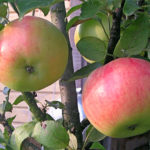
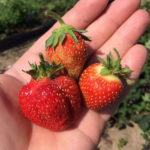
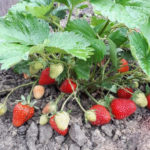
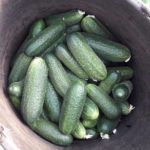
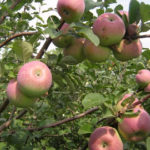




Pear Curé - for 3 years the yield is large, and the taste is terrible and is not stored at all. Advise what to do.
My family and friends like the pear very much. I rent it for storage in the second half of September. Store in banana boxes, wrapping or shifting with paper. The boxes are kept in a closed summer kitchen. Temperature and humidity are practically stable. After 1 - 1.5 months, when you enter the room, you can immediately hear that the pear is reaching its condition. One minus, when you take it out of storage and bring it into the heat, it is stored for 3 days and that's it. They overripe quickly and darken with spots. The appearance deteriorates, but the taste is excellent, very juicy. We are satisfied.
This is not Cure: The shape is not the same, and on the fruits that you showed, you can see a dark line that crosses the whole pear. Curé (Abat) with a more elongated shape, heavier, taste very good and becomes suitable for one earlier. It has an aroma, and this variety either barely noticeable, or it does not exist at all.
I want to add: the fruits of this variety are very watery and short-lived. The taste is not the same as that of Kure (Abat Fetel) - I want to wish for much better
The correct name is Parskaya, in Bulgaria - Popskaya. Otherwise, a confusion turns out: Abat Fetel and Kure are the same variety (look at this in Western literature), and Popskaya is a completely different variety. Perhaps the best name is Williams winter - they are similar at least in appearance.
I have 3 Cure pears. The oldest is from 1945, the rest is from the 60s. Last year I took more than 600 kg of pears. I have buyers who only buy Curé and others who don’t. From padanka I make great juice without sugar, as soon as you squeeze out the juice and immediately boil and immediately close it in a bottle, sweet, very tasty and healthy. And so I sell everything on the market. There is always a demand. You just need to be careful so that the yellow one, as soon as it appears, is immediately on the market and so to choose and sell. And yet, the author can be seen just dashed off any buzz from the Internet and does not know that the variety has one weakness - the fragility of the branches and serious branches can collapse along with the harvest as sawn, but then a growth is formed around the break, which can simply be brought to the desired branch and recover the loss.